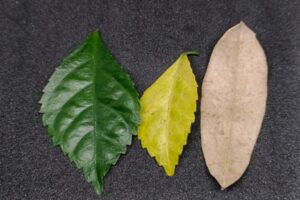
Trees are the silent sentinels of our yards, streets, and forests. Their changing colors throughout the seasons not only mark the passage of time but also reveal a lot about their health. In the fall, trees display a spectacular spectrum of color as chlorophyll breaks down on cool nights, allowing yellow and orange pigments to shine through. This seasonal change is a healthy process, indicating that the tree is functioning normally. However, premature fall color might suggest something else.
If your trees exhibit fall colors too early or exhibit any other unusual colors, it might be time to consult with our team at Rick’s Certified Arborists. We provide professional insect and disease control services, along with treatments like Tree Planting, Deep Root Feedings, Soil Injections, and Trunk Injections, to preserve the long-term health of your trees.
Green Leaves
Healthy tree leaves showcase a lush green appearance, a sign that they’re photosynthesizing efficiently. Chlorophyll, the green pigment, is crucial here as it absorbs light from the sun, particularly in the blue and red spectrums, while reflecting green light. This green color indicates that the tree is manufacturing food through photosynthesis, converting sunlight into energy.
When trees receive adequate water and nutrients, green foliage remains vibrant. However, if you notice the green leaves starting to lose their green pigment, it might indicate issues such as nutrient deficiencies or diseases.
Yellow Leaves
Leaves turning yellow outside of normal seasonal change is a condition known as chlorosis, which means a lack of chlorophyll. This can happen for several reasons. One common cause is nutrient deficiency, particularly a lack of iron or nitrogen, which are essential for chlorophyll production. Iron deficiency often causes interveinal chlorosis, where the area between the veins turns yellow while the veins remain green. This pattern is a critical clue in diagnosing the issue. Nutrient deficiencies usually result from compacted or waterlogged soil, which can prevent roots from absorbing nutrients properly. It can also be caused by poor soil quality or imbalanced fertilizer applications.
Another possible reason for yellowing leaves is a fungal disease such as root rot or Veriticillium Wilt. These diseases attack the plant’s root system, preventing proper nutrient uptake and leading to chlorosis in the leaves. In some cases, environmental factors such as excessive bright light from the sun or extreme temperatures can also cause yellowing leaves. In these situations, the yellowing is usually temporary and will resolve itself once conditions improve.
Orange Leaves
Orange leaves are less common but can be equally concerning. They may indicate a fungal infection or other diseases affecting the tree. For instance, certain fungal infections can cause leaves to turn orange or develop orange spots. Rust diseases, caused by various fungi, often result in bright orange spots or pustules on the leaves. This can be seen in both deciduous and evergreen trees. The orange color is due to the presence of carotenoids, pigments that are usually masked by chlorophyll but become visible when chlorophyll breaks down.
Another potential cause of orange discoloration is the presence of pests. Insects such as aphids or spider mites can damage leaves, leading to a breakdown of chlorophyll and the appearance of carotenoids. Environmental factors, such as exposure to pollutants or extreme weather conditions, can also cause yellow and orange colors in leaves.
Brown Leaves
Brown leaves are often a sign of drought stress or root damage. When a tree does not receive enough water, it cannot maintain the turgor pressure needed to keep leaves healthy, leading to brown, crispy leaves. This is particularly common during periods of prolonged drought or when trees are planted in areas with inadequate irrigation. Brown edges or tips on leaves can also indicate salt damage, often from over-fertilization or exposure to road salts in winter.
Additionally, root damage from construction or other disturbances can impair a tree’s ability to absorb water and nutrients, resulting in brown leaves. Diseases such as anthracnose or bacterial leaf scorch can also cause browning of leaves. In these cases, the browning is often accompanied by other symptoms, such as wilting, leaf drop, or cankers on branches.
Red Leaves
Red leaves can be striking but are often a sign of stress. In some cases, red leaves are due to a nutrient deficiency, particularly phosphorus. Phosphorus is essential for energy transfer and photosynthesis, and a deficiency can cause leaves to turn red as the tree attempts to redistribute its limited resources. Red coloration can also be a response to environmental stressors such as cold temperatures or drought.
Trees may produce anthocyanins, pigments that appear red, as a protective measure against stress. These pigments can help protect the leaves from damage by ultraviolet light or oxidative stress. In some cases, red leaves can be a sign of disease, such as certain types of leaf spot diseases that cause red or purple lesions on the leaves.
Rick’s Certified Arborists Treatment Options
At Rick’s Certified Arborists, we offer a range of treatment options to address the underlying causes of tree leaf discoloration. Our insect and disease control services are designed to safely eliminate unwanted insects that have taken up residence in your trees and provide practical remedies for trees that have fallen ill.
Soil injections are another effective treatment option. By injecting nutrients directly into the soil, we can address nutrient deficiencies that cause many different issues. This method ensures that the nutrients are delivered directly to the root zone, where they can be readily absorbed by the tree. Trunk injections are also available for more severe cases. This method involves injecting nutrients or treatments directly into the trunk, ensuring rapid uptake and distribution throughout the tree.
For trees suffering from drought stress or root damage, our deep root feedings can provide the necessary support. This method delivers water and nutrients directly to the root zone, helping to alleviate stress and promote healthy growth. We also offer advice on proper watering practices and can assess and improve your irrigation system to ensure your trees receive adequate water.
Don’t Get Discouraged By Leaf Discoloration! Call Rick’s Today!
Understanding tree leaf discoloration is crucial for maintaining the health and beauty of your trees. At Rick’s Certified Arborists, we are committed to providing the highest quality tree care services to address the various factors that can cause leaf discoloration.
If you notice unusual colors in your tree leaves, don’t hesitate to contact us. Our team of certified arborists has the expertise and experience to diagnose and treat the underlying issues, ensuring your trees remain vibrant and healthy.

Comments are closed.